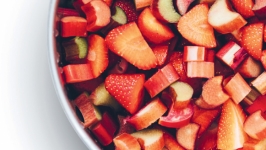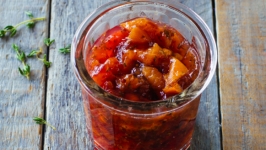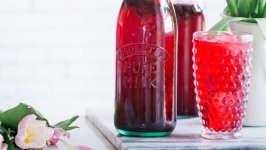Falling for Rhubarb
Rhubarb is the rebel of the vegetable world. It looks like celery, tastes like sour candy, its leaves are poisonous, and unlike most spring and summer produce, it’s barely edible raw. With such a feisty personality, it’s no wonder many are too intimidated to cook it at home. But with a little coaxing and a good dose of sugar, I promise it’ll reveal a more docile side.
Along with ramps, rhubarb is one of the very first signs of spring. All season long, you’ll see the stalks sold as bunches at farmers markets, next to bundles of asparagus and baskets of strawberries. You’ll recognize its large, firm stalks, ranging from light green to deep pink depending on the variety.
If you’ve never had it, start experimenting with a pound of the vegetable. At home, discard the leaves into your compost piles and store the stalks for up to a week in your crisper drawer. When you’re ready, cut them in ½-inch slices and turn them into a sweet-and-sour delight.
A simple compote is a great way to get acquainted with the feisty veggie. As a rule of thumb, rhubarb will need 20% of its weight in sugar to be palatable. Depending on your mood and what’s in the market, you can simply cook it with sugar or pair it with strawberries (recipe follows.) Enjoy the compote straight or flavor it with a few drops of rosewater or vanilla extract. Although rhubarb stands on its own, it also plays well with others. Consider pairing it with raspberries, ginger, or fennel in cakes, crisps, and other recipes.
If, like me, you turn into a rhubarb fan, remember that it’ll be gone when the hot summer days roll around. The good news is that rhubarb freezes beautifully. Wash and cut it into ½-inch slices and freeze it for up to a year in an airtight container. It’s the best way to invoke early summer memories.
Note: Both granulated cane sugar and demerara sugar will work in the recipes. To boost their nutritional value, consider using the less refined demerara sugar.









